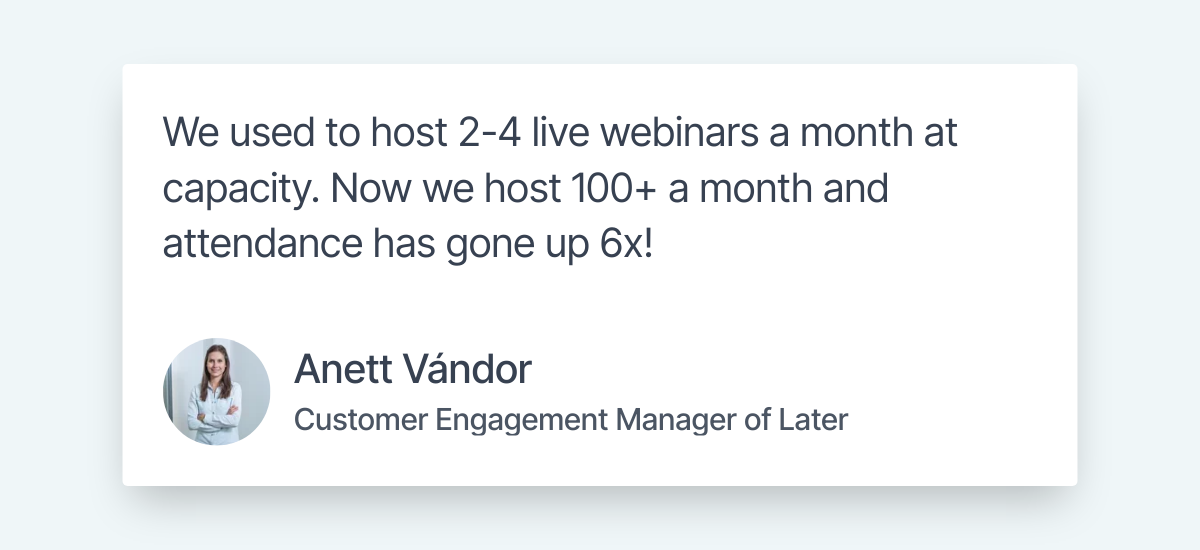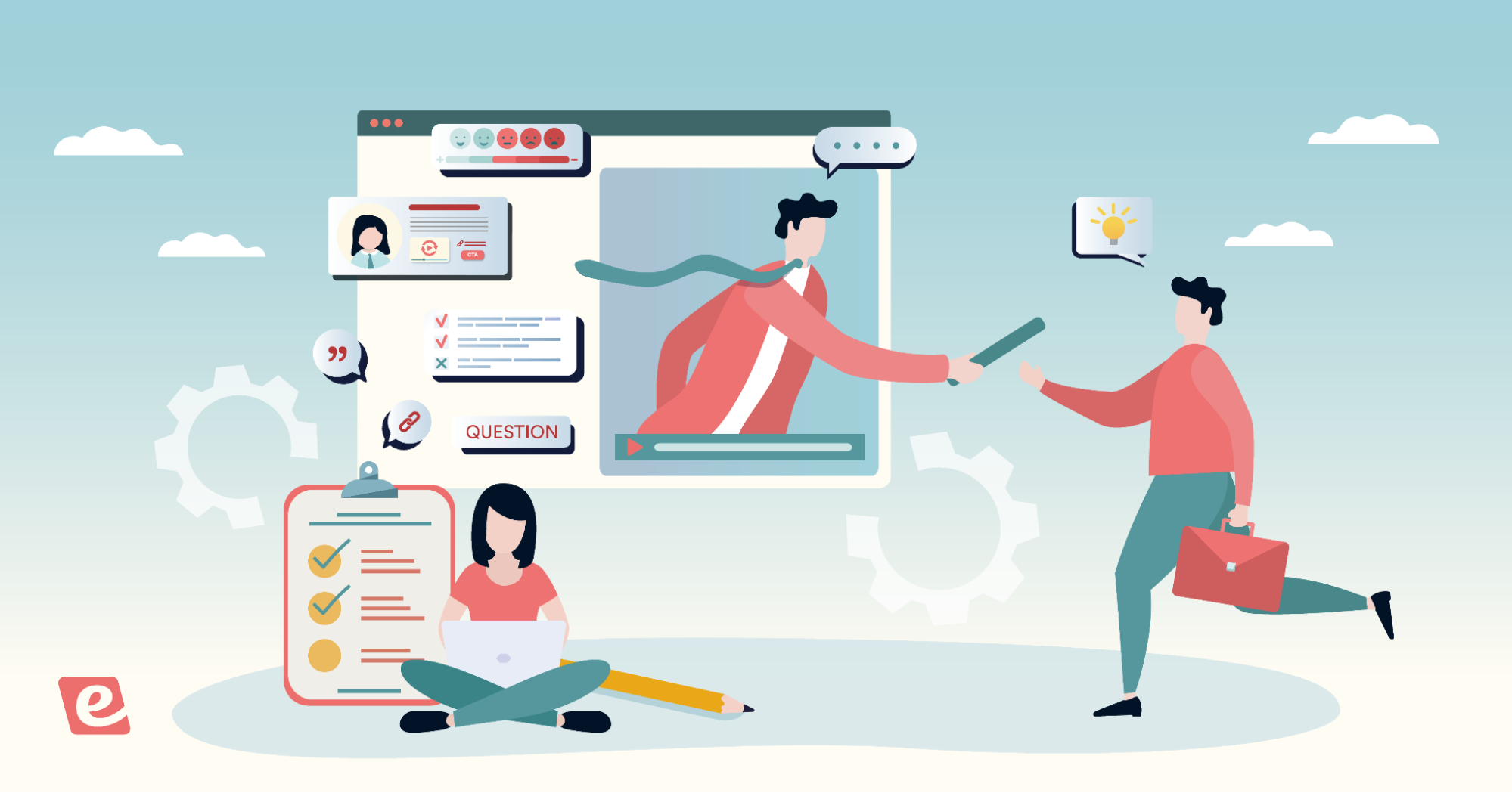Hundreds of SaaS companies use our webinar platform, eWebinar, to onboard users to their products so we're deeply familiar with the challenge of vetting onboarding solutions and the many challenges standing in the way of customer activation.
If you're looking for a digital adoption platform to help with user onboarding OR already use one of these tools but want to switch over, our in-depth comparison will help you find the right software for your needs.
The platforms we'll be comparing today are:
Quick question: are you onboarding users with webinars? If so, you already know that webinars are often the most effective way to onboard users but eat up countless hours of your time because you have to do them over and over again.
Pre-recorded tutorial videos, on the other hand, are scalable but create a passive viewing experience and don’t let you be there to respond to new user questions.
We built eWebinar to give you the best of both worlds: the ability to automate your webinars while still being able to engage with attendees via live chat.
So if you're burnt out from repeatedly hosting live onboarding webinars, watch our on-demand demo or skip ahead to learn how eWebinar can help!


Without further ado, let's dive into the product comparison!
Appcues vs Pendo vs WalkMe
All three product adoption tools in our comparison include mobile compatibility which means you can use them for both web apps and mobile apps. The sections below will go over key features, integrations, and pricing so you have everything you need to make an informed purchase decision!
The three criteria we'll be using to evaluate these platforms are:
-
In-app guidance. First and foremost, we'll be looking at the in-app guidance capabilities of each platform. This includes how easy it is to build and customize their product tours.
-
Product analytics. Next, we'll be comparing the product analytics capabilities between platforms. This includes a combination of product usage metrics and content engagement tracking.
-
Automation capabilities. Finally, we'll look at which integrations each tool supports and factor in any AI-powered features (such as WalkMe's DeepUI).
Appcues: Overview, Features, and Pricing

Appcues is a product adoption platform used by companies like Hotjar, GetResponse, and AdRoll.
Appcues in-app guidance
Appcues has a user-friendly drag-and-drop builder that lets you create flows completely code-free. You can add UI patterns such as modals, slideouts, tooltips, or hotspots depending on how subtle you want your flow to be.
Audience targeting is quite robust as well letting you segment users based on their use case, team role, subscription tier, lifecycle stage, and more. Unfortunately, Appcues struggles with element detection at times — which can make tasks like adding tooltips cumbersome.
Appcues product analytics

Appcues support goal tracking, issue reporting, and NPS analytics to mark a data-driven path toward improving user sentiment. You'll also be able to A/B test your in-app flows, review survey responses, filter reports by segment, and track inactive customers who are at risk of churning.
Appcues' click-to-track system offers no-code event tracking by letting you define events — either a click, hover, or text input — from within the same builder you use to create flows. You can then use the event list to see your tracked events and how many times they've occurred in the past week or month.
Appcues mobile features
The Appcues mobile builder lets you choose a modal size, style buttons, and use custom fonts to make flows feel like a native part of your mobile app. When you're done, all you have to do is scan a QR code to preview the flow on your smartphone before publishing it.
Tip: You can set buttons to trigger/advance/dismiss a flow, go to a specific URL, and more.
Best of all, you'll be able to build and update flows for your mobile app without the need for engineering support or App Store/Play Store approval. You can add modals, slideouts, tooltips, surveys, and even actions that trigger other flows — all culminating in a seamless cross-platform user experience.
Watch the video below to see how you can build mobile app onboarding flows using Appcues:
Appcues automation
Appcues workflows let you automate various processes using the 45 integrations available on the platform. These include a wide range of tasks such as sending Slack messages to users who complete their onboarding checklist or forwarding NPS data to Salesforce, HubSpot, and Google Sheets.
You can even embed Zendesk articles, Loom videos, and Calendly links within in-app flows to create a richer onboarding experience. Lastly, Appcues also integrates with Zapier which enables you to choose from thousands of tools when automating workflows (or build your own using the Appcues API).
Appcues pricing
Appcues is the only platform of the lot that lists pricing on its website. Affordability aside, this already puts it ahead in terms of cost transparency. There are three plans to choose from but all of them are billed annually.
-
Essentials. Starts at $249/month and includes three team members, five audience segments, and up to 10 tracked events.
-
Growth. Starts at $879/month and includes 10 team members, unlimited audience segments, unlimited tracked events, and unlimited integrations.
-
Enterprise. Uses quote-based pricing and includes unlimited team members, single sign-on (SSO), enterprise account administration, and access to activity logs.
Note: Those on the Essentials plan will only have access to Appcues support via email.
Pendo: Overview, Features, and Pricing

Pendo is a product experience platform used by companies like Agorapulse, BombBomb, and GoTo.
Pendo in-app guidance
Pendo's Visual Design Studio lets you build no-code guides with tooltips, banners, polls, and lightboxes — which are essentially modals. You can also use the same browser-based designer to build guides for saved pages on your mobile app (more on how to set this up later).
Once you've built and published your guides, Pendo lets you run experiments to measure the content's impact on user behavior. You can adjust how many users to include in the experiment and set notifications that remind you to check on results after a certain period of time.
Note: Pendo recommends having a sample size above 1,000 users to get the most accurate results.
Pendo product analytics

Pendo collects a myriad of product usage, path tracking, and NPS data. You can then surface those insights by adding any of Pendo's 39 metrics widgets to your dashboard. These dashboard widgets create unparalleled customization options but that comes at the cost of a steeper learning curve.
Pendo for Mobile automatically starts tracking screen views and element clicks from the moment the SDK is installed. In other words, Pendo's retroactive analytics can surface historical data even if you've just tagged a feature on your mobile app. Lastly, you can filter data by app version or operating system.
Pendo mobile features
To get started, you can pair your mobile device with Pendo by scanning a QR code. Once that's done, you'll be able to tap on the camera widget on your phone to screenshot any page on your application. This will capture any clickable elements that you can then manually tag as features.
Pendo also lets you assign pages and features to specific groups (e.g. dashboard or navigation) in order to better categorize them. After you've properly tagged everything, you can use cross-platform path tracking to see if users are switching between devices for certain workflows.
Watch the product demo webinar below to see how Pendo's mobile features work:
Pendo automation
Pendo lets you automatically generate walkthroughs in seconds by setting the maximum number of steps, typing a prompt of what to guide users on, and selecting a tone for the content. You can also look at workflow insights to get suggestions for which workflows or steps to build in-app guidance for.
Pendo's product areas also use AI to generate a user feedback summary — based on qualitative customer feedback and NPS data — listing popular complaints/requests. Finally, you can enable AI localization to automatically translate guides into any language supported by your product.
Pendo pricing
Pendo offers one free plan and four paid plans (which all use quote-based pricing). The free version is limited to 500 MAUs, doesn't include integrations, and won't even let you contact Pendo support — ultimately making it feel more like an extended trial.
-
Free. The free version can be used on products with up to 500 monthly active users. It includes Pendo-branded surveys and limited reporting capabilities.
-
Base. The Base plan provides full access to Pendo's analytics features and unlocks integrations but doesn't include surveys.
-
Core. The Core plan includes everything in the Base plan plus access to session replays. You can capture unlimited sessions with 30-day retention.
-
Pulse. The Pulse plan re-unlocks surveys (this time without Pendo branding). This includes NPS surveys, feedback triaging, and AI-generated summaries.
-
Ultimate. The Ultimate plan contains everything Pendo has to offer including all paid add-ons for its in-app guides.
WalkMe: Overview, Features, and Pricing

WalkMe is a digital adoption platform used by companies like Deloitte, Nestlé, and IBM. Unlike Appcues or Pendo, WalkMe was built to onboard both users and employees.
WalkMe in-app guidance
The WalkMe Editor lets you build walkthroughs using steps and popups. Steps appear as tooltips attached to specific elements that guide users and contain a preset trigger that advances the walkthrough to the next step. Popups appear in the center of the screen and offer additional context.
You can also add flow steps that work behind the scenes to adapt flows based on user behavior. This includes taking users down different branching paths based on their selections or waiting for a specific condition to be met before advancing the walkthrough.
Tip: The WYSIWYG editor lets you easily customize your content and import media.
WalkMe product analytics

WalkMe automatically shows you product usage data for every application in your tech stack. For each product, you'll see the total number of users, how often they use it, and for how long. You can also use WalkMe's workflow analytics to identify bottlenecks and see how users interact with in-app guidance.
The WalkMe mobile console also comes with advanced analytics tools that surface various metrics like DAU/MAU ratio, retention rates, session time, sessions per user, geographic data, and more. This makes key mobile analytics easily accessible through any web browser.
WalkMe mobile features
The WalkMe Mobile SDK can be added to any app on iOS or Android by adding a single line of code. Just ensure your application is on at least iOS 8.0 or Android 4.1 as older versions won't be compatible with the SDK.
Once installed, you'll be able to build in-app guidance, flows, and surveys into your native mobile application without writing any code. WalkMe can even automate navigation workflows to take users to specific parts of your mobile app without them having to tap through multiple menus manually.
Watch the video below to see WalkMe Mobile in action:
WalkMe automation
Whenever the interface of a product changes, DeepUI — which was acquired by WalkMe in 2018 — uses AI-based element recognition to update interactive walkthroughs automatically. This is ideal for products that receive frequent updates and would otherwise require manual re-tagging of elements.
The WalkMe Workstation desktop app (available on both Windows and Mac) lets you add widgets, search content, start workflows, and automate tasks from all integrated tools. Available integrations include Zendesk, Salesforce, Slack, Google Drive, Microsoft Teams, and more.
WalkMe pricing
While not displaying pricing on its website, it's widely known that WalkMe is the most expensive solution on the market. It offers separate plans depending on whether you're onboarding employees or customers as well as employee onboarding add-ons.
-
Digital Adoption Platform. This user onboarding plan includes interactive guides, self-serve content, smart audience targeting, and customer surveys.
-
Essentials. This employee onboarding plan includes two pre-built sales/HR workflows, hands-on setup assistance, and a four-week deployment timeline.
-
Core. This employee onboarding plan includes analytics, in-app guidance, unlimited workflows, omnichannel support, and admin controls.
Note: WalkMe's add-ons include enterprise analytics/security and remote collaboration.
How to scale onboarding webinars with eWebinar
Hosting onboarding and training webinars live can eat up all of your customer success team's time and burn them out. That's why our automated webinar platform, eWebinar, was built to save countless hours and avoid webinar fatigue while increasing attendance in the process.
Watch this one-minute video for a quick overview of eWebinar or join our on-demand demo for a more detailed overview!


Flexible scheduling to double your attendance rates
eWebinar lets you make webinars available on-demand and automate them on a recurring schedule. This makes it as convenient as possible for users to attend your webinars and typically doubles the attendance rates of our customers as a result.
Some customer success teams using eWebinar see an even greater boost like Later who were able to 6x their attendance after switching from doing live webinars:

Live (or asynchronous) chat for a white-glove experience at scale
While switching to pre-recorded webinars can help you reclaim your time, it’s not enough to just record a static video and call it a day. The reason that webinars are so effective at onboarding users comes down to the two-way communication between hosts and attendees.
This is especially true for onboarding webinars where new users might have questions that customer success managers need to answer before they can continue. Even just knowing someone is available to answer any questions can create a lasting positive impression.
If you want to be there for your users without getting stuck in an endless loop of live webinars then you need live chat. It’s the only way to continue to provide a white-glove customer experience while being able to scale sustainably.
Here’s how eWebinar’s chat capabilities work:
-
Automated welcome messages. Users see a personalized welcome message as soon as they join the webinar. If no one’s there to reply, the auto-response will set expectations for when attendees will hear back.
-
Instant message notifications. When users message you through the webinar chat, you (and any assigned moderators) will be notified through email, browser notifications, or Slack alerts.
-
Live chat + email responses. Hosts can reply to attendees watching the presentation in real time through the live chat. Any responses sent after the webinar has ended will be automatically forwarded to the email address they used to register.
Our chat system was designed to ensure that every question gets answered without being a massive drain on your customer success team. After all, replying to questions asynchronously is far less stressful than trying to keep up with chat during a live webinar while also presenting.
By rescuing you from webinar hell, you can redirect the time and energy previously spent on hosting recurring webinars toward creating more advanced self-service content for customers or improving other aspects of the user experience.
A variety of interactions to increase engagement and watch times
Last but not least, eWebinar lets you add interactions — like quizzes and polls — that increase watch time by keeping attendees engaged while simultaneously collecting invaluable customer feedback.

If you want to see eWebinar in action then just watch our on-demand demo to experience an interactive automated webinar firsthand!


Conclusion: Which One is Best?
Despite not being a perfect platform, Appcues is the best overall choice. Appcues' intuitive no-code builder, click-to-track analytics, and transparent pricing more than make up for its finicky element detection.
Meanwhile, tech-savvy product teams who aren't afraid of a steep learning curve could reap a lot of value from Pendo's high level of customizability. Pendo is also an attractive choice for bootstrapped startups in need of a freemium solution.
Finally, WalkMe is best reserved for large organizations trying to drive user and/or employee adoption across multiple channels. WalkMe's impressive cross-platform capabilities — working on mobile devices, web browsers, and native desktop applications — are matched only by its high price point.
Whether you're a customer success or support team, it's clear that robust user onboarding flows can increase activation rates while reducing ticket volume. However, more complex products and workflows may require longer-form training content in the form of onboarding webinars.
To benefit from the efficacy of webinars without being bogged down by the time-intensive process of hosting them live, webinar automation is the logical (and only) path forward. If you're already hosting onboarding webinars or plan to, watch our on-demand demo to see interactive automation in action!


Artículos relacionados









